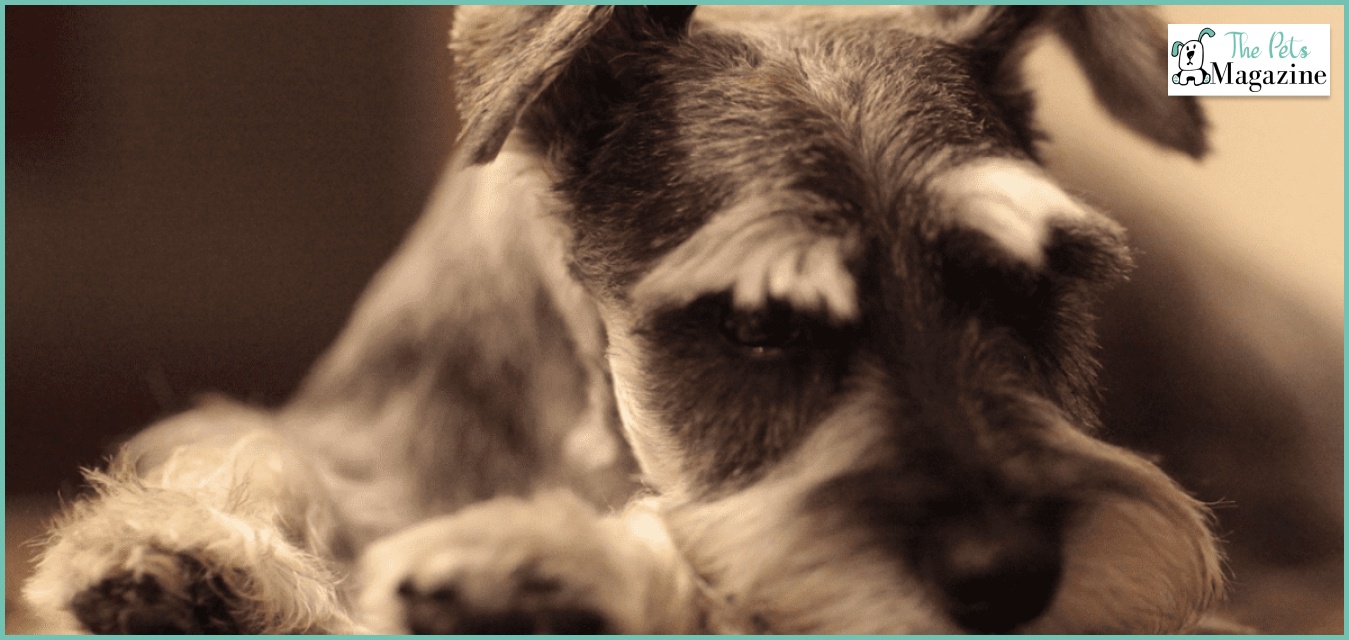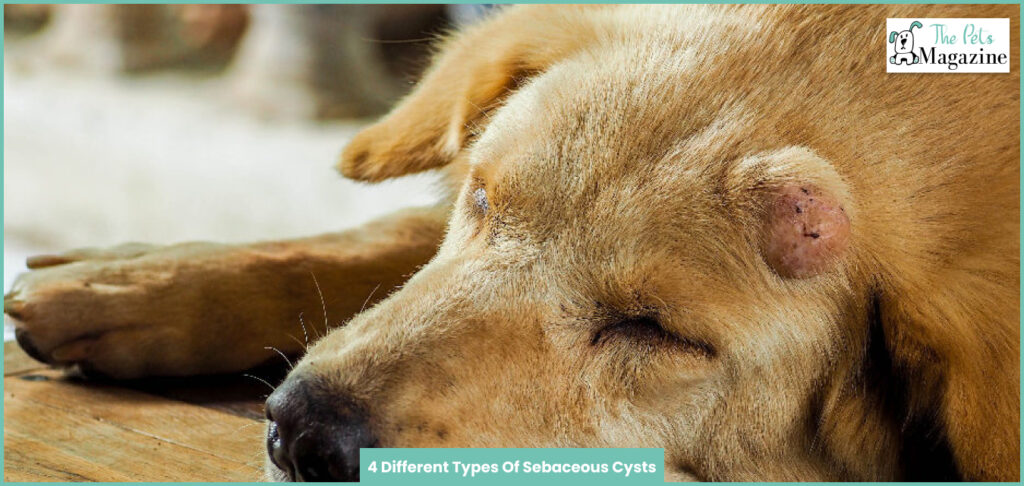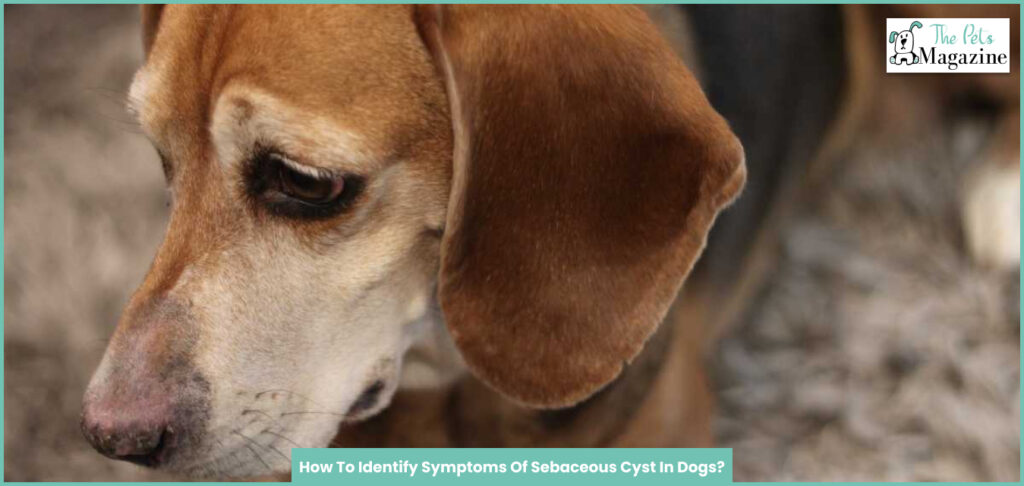What Is a Sebaceous Cyst Dog & How To Drain A Cyst On Your Dog?


Excessive sebaceous gland oil production for your pets can lead to acne problems like humans. But for sebaceous cyst dogs, this is a little different. They are more sensitive to pain and have cysts filled with hard or soft pusses. When you touch your dog’s skin, you will feel small bumpy skin underneath the thin layering of far.
Let’s see first what the sebaceous cyst dog are.
What Are Sebaceous Cysts In Dogs?

The sebaceous cyst dog is a swelling area underneath your dog’s skin. They are forming like small bumps and hives. The most common reasons for this cyst are blockages of the hair follicles due to dirt, scar tissue, and debris.
These cysts are also known as sebaceous gland tumours. These cysts happen when the dirt and dead skin tissues block the dog’s skin pores and hair follicles.
Sebaceous cysts in dogs are relatively common and typically harmless skin growths. They form when the sebaceous glands, which produce an oily substance called sebum to lubricate the skin and hair, become blocked or damaged. These cysts can appear as small, round bumps under the skin and may be filled with a white, cheesy, or oily material.
They often look like small, firm, raised nodules on the skin. They can vary in size and may sometimes become red or swollen if irritated. Sebaceous cysts can occur anywhere on a dog’s body but are commonly found on the head, neck, back, and belly.
Read on to learn more about sebaceous cysts in dogs are.
What does a sebaceous cyst look like?
There are different types of cysts and that is why th appearance and symptoms also varies. Let’s see what the symptoms are:
- A particular area of the skin might get raised or form a nodule.
- The cysts might be elongated and round.
- Some cysts even move a little under the skin.
- The size may vary. It can be less than half an inch or it might be over two inches.
- There can be multiple growths.
- Cysts can even get inflammated.
- Cysts often bleed.
- You might also notice a yellow substance oozing out of the cyst.
What Are The Causes Of Sebaceous Cysts In Dogs?

Not every time can you blame the dirt and skin scar skin tissues for sebaceous cyst dog, apart from the dirt and skin tissues. There are many more reasons which are linked with the growth of sebaceous cysts among dogs.
Here are some reasons for dog sebaceous cyst.
Read more: Ten Best Dog Snood For Your Dogs
1. Injury And Sudden Trauma:
A Sebaceous cyst can also appear due to injury and trauma. Sometimes the injuries increase the oil production of the glands. And these types of traumas lead to the sudden growth of the glands.
2. Imbalance In Hormonal Secretion:
This type of problem is similar to humans. During the puppy’s growth period, the hormonal secretions become different. The testosterone and progesterone hormonal imbalance conditions are leading to these problems.
3. Generic Linked Factors:
Some breeds are highly prone to a sebaceous cyst on dogs. For example, Yorkshire terriers and Schnauzers. And these sebaceous cyst dog problems are also linked with genetic factors.
4. Hair Follicles Blockages:
This is the principal reason. Sometimes the dog’s hair follicles are blocked by the oil, Injuries, debris, and infections. These blockages of the skin tissues lead to the sudden growth of the sebaceous cyst dog.
5. Insect Bites And Age Factors:
This sebaceous cyst dog is a prevalent problem in many older dog breeds. Even sometimes, due to insect bites, it can happen.
Blue German Shepherd: Know more why the german shepherd is one of the most popular dog breeds in the United States A Complete Breed Profile.
6. Swollen Hair Follicles:
Sometimes the sebaceous cysts in dogs are caused by swollen and ingrown hair follicles. In addition, dogs are often scratch and bite that area. And these types of things are starting to lead to sudden growth in the sebaceous cyst.
7. Sun Damage
Excessive exposure to ultraviolet (UV) rays can damage the skin and hair follicles, potentially contributing to cyst development.
8. Inflammation or Infection
Inflamed or infected skin can disrupt the normal functioning of hair follicles and sebaceous glands, leading to cyst formation.
9. Scar Tissue
Scar tissue buildup from wounds or healed infections can obstruct follicles and contribute to cyst development.
10. Hair Follicle Inactivity
In hairless breeds like the Mexican Hairless Dog and Chinese Crested Dog, where hair follicles are less active, sebum buildup can lead to cyst formation.
Different Types Of Sebaceous Cysts

Unless you can not find out the reason and type of sebaceous cyst dog, you can not find the exact treatment procedures.
Here are four types of sebaceous cysts among dogs.
1. Sebaceous Gland Adenoma
This type of sebaceous cyst dog is usually found on your pet dog’s head or on the eyelids. And cysts are covered with crust.
If you are looking for a small, furry friend to bring home as your pet then Maltipoo dogs are the best choice.
2. Sebaceous Gland And Hyperplasia
When the overgrowth of the sebaceous gland is happening, these overgrowths of glands lead to sebaceous cyst growth. Usually, you can find this cyst on the older dog’s head and abdomen.
3. Sebaceous Gland Hamartoma
These types of sebaceous cyst dogs are common among newborn puppies. Usually, this cyst will not grow more than 2 inches.
4. Sebaceous Adenocarcinoma
This type of sebaceous cyst dog is pretty harmful. You can find this cyst on the skin of elderly dogs. Cysts are sometimes metastasized to the lymph nodes and lungs.
How To Identify Symptoms Of Sebaceous Cyst In Dogs?

The symptom of the sebaceous cyst dog is similar to other skin itching problems. These problems are easy to identify. When you have a canine friend in your home, you have to monitor all the factors related to their health closely.
Here are some of the symptoms. Read it and identify the symptoms.
- First, you will find a lump in the infected area.
- The cyst’s colors are blue.
- The usual spots for sebaceous cyst dogs are the neck, head, upper legs, and torso areas.
- Red infection, lumpy skin, and swelling.
- Hair loss around the infected areas.
- Pain with bleeding.
- Unusual Fluid discharge.
- Multiple lumps underneath the skin.
- Unpleasant smell and lesions.
My first suggestion is if you are finding any types of these symptoms. Consult your veterinary doctor immediately to find easy solutions. Most of this sebaceous cyst on dogs is easily treatable.
Diagnosis of sebaceous cyst
You might find something unusual, or a lump on your fur baby’s body, but it is only possible for a vet to diagnose if that is a sebaceous cyst or not. They will check your fur baby thoroughly and then they will only be able to tell what that lump exactly is.
There have been studies that say that histopathology is the best way to evaluate and examine the tissues that actually form the cyst. The procedure involves microscopic examination of the tissue, to find out what kind of the cyst that is.
With the process of histopathology, the vet would be able to determine the cause of the cyst, discover the prognosis as well as rule out if there is any other skin condition.
What Are The Treatment Of Sebaceous Cyst?

With the sebaceous cyst dog symptoms, you will know when you will require the medications. But along with the symptoms, you also have to know some of the other factors.
Here is some information which guides your doctors in the proper way of diagnosis.
- The status of the cyst.
- The cysts numbers.
- Your pet’s health condition.
1. Antibiotics
Apart from the common areas, many times, the sebaceous cyst on the dog paw also happens. For these types of areas, antibiotic medications and skin ointment is enough to treat the spots.
Antibiotics are used to treat secondary infection areas. Sometimes the sebaceous cyst keeps coming back. But if you find your cyst on your dogs in the shrinkage state, that means your medications are working.
2. Anti-Inflammatory Medicines
The sebaceous cyst dog can be inflamed and pretty painful for your pups. So if your vet doctors are going to prescribe medications, it will relieve your pet from severe pain. These medications are available in many forms, like oral or topical steroid creams.
All you have to do is consult your doctors at the right time. And right time consultations are going to solve your pet’s 70% of the health issues.
3. Extraction And Biopsy
If you are asking the consultations from the veterinary doctors on time. The doctors are going to treat the cyst with simple antibiotics or anti-inflammatory drugs. But in the advanced state, these cysts will require a biopsy test. Even cyst removal with operations is also possible.
This is why I suggest you consult your vet doctor immediately if you find any bumpy skin during bath or petting. After the extraction or draining, your doctors will prescribe antibiotics to prevent further infection. Follow their guidance.
For every sebaceous cyst dog, monitor the wound healing process. And if the wounds are taking more time to heal, inform your doctor immediately.
Are There Any Home Remedies For Treating These Cysts?
While it’s essential to consult your veterinarian for a proper diagnosis and advice, there are some home remedies you can consider for treating sebaceous cysts in dogs. Remember that these remedies should only be used if your vet has confirmed that the cyst is benign and safe to manage at home. Here are five easy methods:
Regular Observation and Monitoring:
Keep an eye on the cyst’s size, shape, and appearance and note any changes over time.
If the cyst remains stable and doesn’t grow or become infected, your dog may not need immediate treatment.
Gentle Cleaning and Topical Treatments:
If the cyst ruptures on its own, clean the area gently with mild soap and warm water. Then, apply a topical antibiotic ointment as recommended by your vet. At the same time, you should avoid squeezing or puncturing the cyst yourself to prevent infection and scarring.
Warm Compresses for Relief
Applying warm compresses can provide relief and encourage healing. To do so, soak a clean cloth in warm water, wring out the excess, and apply it to the cyst for 5-10 minutes several times a day. Ensure the temperature is comfortable for your dog to avoid burns or discomfort.
Dietary Adjustments and Supplements:
While there’s no direct diet to cure sebaceous cysts, maintaining overall health can help manage and prevent them. A balanced diet rich in essential nutrients supports skin health and immune function. Some pet owners find that adding omega-3 fatty acids to their dog’s diet improves skin condition and reduces cyst occurrence (consult your vet before making dietary changes).
Can You Drain A Dog Cyst At Home Safely?

Whenever you find any types of lumps or cysts among the dogs, consult your vet. But if you are experiencing something like this. You can drain your dog’s cyst at your home. The draining of the sebaceous cyst dog is giving your pet excellent pain relief.
Here is a step-by-step guide to drain your dog’s sebaceous cyst at home.
Items You Will Require:
- Epsom salts
- Warm water
- Big bowl or bucket
- Warm compress with a sterile facecloth
- Clean Cotton or absorbent pad
- Antibacterial or anti infomediary tropical ointment
Procedure To Drain Dog’s Cyst:
- Fill the big bowel or bucket with 2 – 4 cups of warm water.
- Then pour 1/2 cup of salt and stir till the salt is fully dissolved.
- Next, use the sterile face cloth for a warm compress.
- After the warm compress, you will see how your dog’s cysts are starting to appear.
- Do not squeeze or prick.
- When you start to apply the warm compress after 2 or 3 days, the skin will be softy, and cysts are beginning to appear as ripe.
- Then only start to drain the sebaceous cyst dog.
- When you start to drain the sebaceous cyst, you will see a different color liquid, and the puss is filled up in the cyst.
Then that area after draining the sebaceous cyst dog. And then apply a thin layer of antibacterial ointment on the affected areas.
Always let the cyst drain in a natural state. Then, you have to apply the warm compressor till it reaches a ripe state.
Recovery process from a sebaceous cyst
If the cyst that has formed in your dog is cancerous then the recovery process would be quite extensive. You have to take good care of them and consult with the vet frequently for follow up appointments.
If it is just a normal cyst, you have to ensure that the area of surgery is cleaned and kept dry. But you have to keep an eye on your dog to keep them away from water, and they should not be bathed without the permission of their vet.
How can I prevent my dog from scratching or irritating the cyst?
Preventing your dog from scratching or irritating a sebaceous cyst is important to avoid infection and promote healing. Here are some steps you can take:
- Elizabethan Collar: Consider using an Elizabethan collar (also known as an E-collar or cone) to prevent your dog from reaching the cyst with its mouth or paws1.
- Keep the Area Clean: Maintain the cleanliness of the area around the cyst to prevent infection and reduce irritation.
- Regular Grooming: Trim the hair around the cyst to prevent matting and keep the area well-groomed.
- Avoid Tight Clothing: Ensure that any clothing, collar, or harnesses do not rub against the cyst, which could cause irritation.
- Monitor Behavior: Watch for any signs of discomfort or excessive attention your dog may give to the cyst, and consult your vet if you notice any changes.
Frequently Asked Questions About Dog’s Sebaceous Cyst
The situations are all depending on the situation of the Sebaceous Cyst. This means the small cysts are not causing too much pain. You can easily pop or squeeze them. But the big-size Sebaceous Cyst needs vet consultations. So if you find any big ingrown, it is better to consult your vet immediately.
Sebaceous cysts are sometimes referred to as sebaceous gland tumors. Even after the single growth, you can see multiple expansions. My suggestion is if you find the single development consult your vet doctor immediately to stop the further spreading. Sometimes the sebaceous cysts on dogs can be cancerous. So keep that point in mind.
From the first glance, Sebaceous Cysts look like a large pimple on your pet’s skin. In 60% of cases, these cysts are not harmful. But the infected areas can be pretty inflamed due to soreness or rupture.
Wrapping Up:
If you are finding any symptoms of sebaceous cyst dog, my suggestion is to rush through your vet and ask for their consultations. The small cyst is easily treatable. But for the large ones, you have to take the help of a vet.
Having a pet in your home is like having your own kid. You have to take care of them like your kids. So are there any pet parenting tips you want to share with us? Then share your pet care facts in the comment sections. To read these types of content, keep following our blog.
Read More :








Leave A Comment